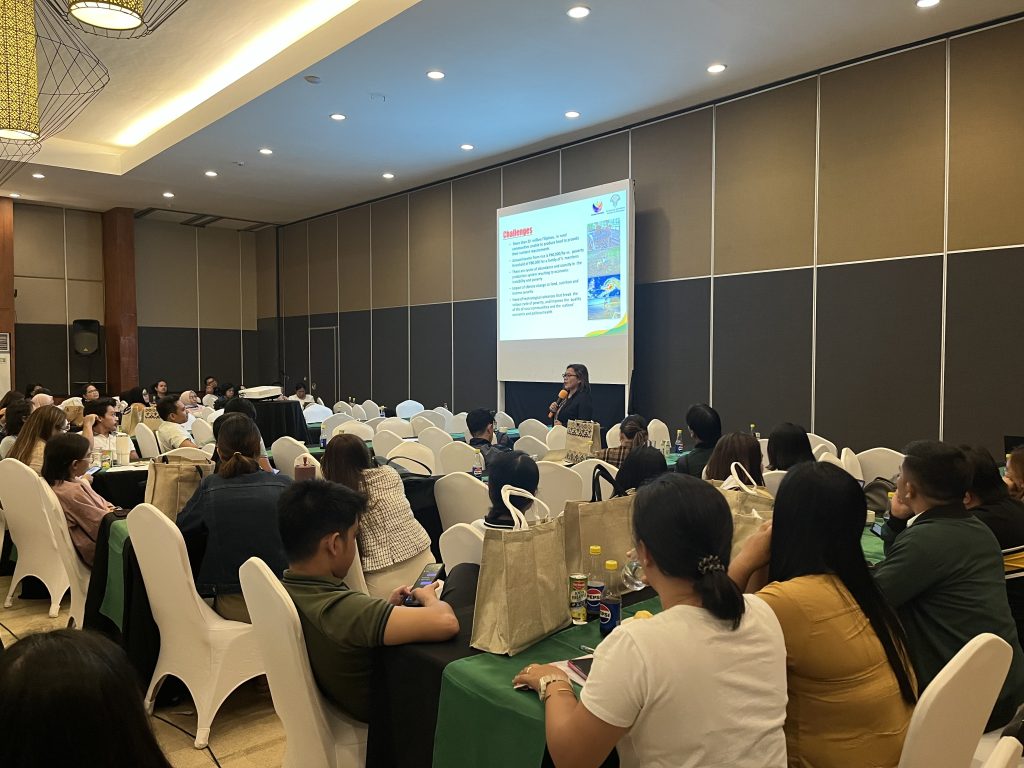
ATI-RTC X through Dir. Echavez tackles the approaches and tools in agricultural extension delivery system during AEW Congress.
CAGAYAN DE ORO CITY – Aimed at empowering the grassroots in boosting and sustaining their production and income, the second day of the staged 2nd Agricultural Extension Workers (AEW) Regional Congress on June 14, continues to bring a series of plenary sessions for capacity enhancement of the same, including on the Basic Approaches and Tools in Extension Delivery System, here.
Hosted by the Department of Agriculture – Regional Field Office 10 (DA-10) under the headship of Jose Apollo Y. Pacamalan, Maria Lydia A. Echavez, center director of the Agricultural Training Institute – Regional Training Center X (ATI-RTC X) rendered the topic before over 400 participants, majority of whom are development partners of the DA, the agricultural extensionists from the different local governments and members of the Philippine Association of Agriculturists, Inc. (PAA) Pineapple chapter across Northern Mindanao, and some from other parts of the country.
At the helm of the bureau, which is the DA’s training arm, here in Region 10, Dir. Echavez said that over time, extension support services has seen the development of approaches and tools similar to that of technology, in the delivery of agricultural programs, services and interventions on the ground .
She detailed the major extension approaches, starting from the transfer-of-technology approach, which is characterized in the linear transfer of technology and information from research to farmers; to the educational, systems, commodity extension; and finally, to the farmer participatory extension approach, which is a more inclusive approach that focuses on participatory learning and involves the engagement of stakeholders.
In addition, she cited the tools in extension differing from mass media, demonstrations, training visit system, and drama/theater plays, and at the center of any of these tools to be employed, is communication, a core competency essential for the correct implementation of extension tools, she added.
“Tools should not be confused with approaches. An approach is a set of steps you take to achieve a goal and tools are what you use to take those steps.” Echavez said.
In the selection of an approach and tool, the director urged for the agricultural extension workers to factor in the connectivity of one’s target audience and their literacy, such as social capital, available resources, demographics and educational level.
Challenging however are the cost, capacity and time, the director conveyed, further emphasizing that the capacity of extension providers will determine which tool can be used.
To ensure success in the adoption of an approach and tool, she likewise underscored that one should look into its potential scalability by starting small and planning ahead for possible expansion and sustainability, accounting on how long a program will run and the availability of funds for such purpose.
“Be flexible in choosing your approaches and tools for implementation. Just be guided on what really is your goal and objective to properly identify the approaches and tools to be used in your assigned locality.” she pointed out.
Revolving on the theme: “Enhancing the Capabilities of the Agriculturists through Technological Innovation Addressing Climate Change and Sustainable Development”, other featured topics during the plenary sessions covered on Conservation Agriculture and Multi-strata Agroforestry System; Soil, Water and Nutrient Management: Practical solution to Mitigate Extreme Weather impacts; and Climate information System: tools for Resilient Agriculture.
Breakout sessions were also done with lectures on Rubber Leaf Fall Disease, Digital Information on Agricultural Biosystem Engineering Management Information System, Heirloom Rice Production, System of Rice Intensification, Palayamanan: Integrated Rice Farming System, Agro-Ecology Based Rice Farming, Adlai Production Technology and Marketing Opportunities, and Bulb Onion Production Technology in Northern Mindanao Environment.# (JLO)
